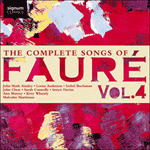This is Gautier (the
Poésies nouvelles again) in the Dardanelles and ‘au bord de l’eau’. The poem has no heading but Fauré changes the poet’s own adjectival ‘seul’ in the second strophe to the feminine ‘seule’ and uses this, together with a dramatic exclamation mark, as his title. The imposing classical economy and severity of the music, and its musically appointed feminine narrator, cannot help but bring to mind that most famous of mourners who waited in vain for a sign of life from the Hellespont – Hero, priestess of Aphrodite, whose lover Leander had drowned there. In order to visit Hero, Leander had nightly swum the four miles (Byron measured the distance by setting himself the same challenge) between Sestos and Abydos. Before committing suicide Hero lamented Leander’s death – perhaps in words like these. Gautier’s visit to Constantinople in 1852 accounts for a reference in the second strophe to the basilica of Saint Sophia, admittedly an anachronism had any classical allusion been intended. But if the poem has set Fauré thinking of this episode in Greek mythology one might opine that this was his first classically inspired song. France’s defeat in the Franco-Prussian war, and the ensuing chaos of the Commune, began a new chapter in French music; the contemporary example of Duparc’s
L’invitation au voyage seems to have given Fauré confidence to write songs in the grand manner. This is his first in the minor key, and the composer no longer strives automatically for a salon-pleasing charm. The music gives the impression of being an obsessive passacaglia punctuated by tolling right-hand octaves.
from notes by Graham Johnson © 2005
Où nous retrouvons Gautier (toujours les
Poésies nouvelles) dans les Dardanelles et «au bord de l’eau». Le poème est sans titre, mai Fauré change le «seul» adjectival de la deuxième strophe en un «seule» féminisé qu’il utilise comme titre, non sans l’avoir assorti d’un théâtral point d’exclamation. L’impressionnante économie classique et l’austérité de la musique, ajoutées à la présence d’un narrateur féminin musicalement désigné, ne peuvent qu’éveiller en nous le souvenir de la plus célèbre éplorée: Héro, prêtresse d’Aphrodite, qui attendit en vain, depuis l’Hellespont, un signe de vie – son amoureux Léandre s’était noyé là en voulant la rejoindre, en tentant de parcourir de nuit, à la nage, les sept kilomètres (Byron mesura la distance en relevant personnellement le même défi) qui séparaient Sestos d’Abydos. Avant de se suicider, Héro pleura la mort de Léandre, peut-être en des termes semblables à ceux du poème. Le séjour de Gautier à Constantinople, en 1852, explique la référence (deuxième strophe) à la basilique Sainte-Sophie, référence qui serait un indéniable anachronisme si le poète avait voulu une quelconque allusion classique. Mais si le poème a bel et bien suscité en Fauré cet épisode de la mythologie grecque, force est de remarquer que
Seule! fut sa première mélodie d’inspiration classique. La défaite française face à la Prusse, et le chaos de la Commune qui s’ensuivit, marquèrent le début d’un nouveau chapitre dans l’histoire de la musique française; la contemporaine
L’invitation au voyage de Duparc semble avoir insufflé à Fauré l’assurance nécessaire à une écriture mélodique grandiose. Seule! est sa première mélodie en mode mineur, et il ne recherche plus systématiquement le charme qui plaît dans les salons. La musique donne l’impression d’une passacaille obsessionnelle ponctuée de résonnantes octaves à la main droite.
extrait des notes rédigées par Graham Johnson © 2005
Français: Hypérion


 Fauré: The Complete Songs, Vol. 4
Fauré: The Complete Songs, Vol. 4
